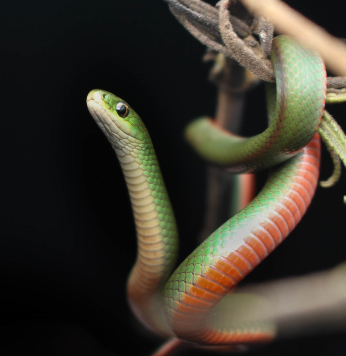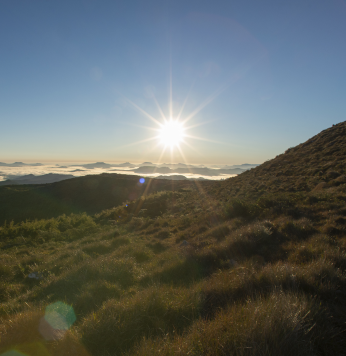RPPNs
NATURAL HERITAGE PRIVATE RESERVES (RPPN)
Klabin has Natural Heritage Private Reserves (RPPNs) in the states of Paraná and Santa Catarina that combined represent nearly 10,000 hectares dedicated exclusively to scientific research, environmental protection and the preservation of natural resources. Maintaining these spaces contributes to biodiversity conservation in the Atlantic Forest biome, since they help to protect many endangered species, which is why the scientific research conducted on both reserves is so important.


RPPN Complexo Serra da Farofa (SC)
O Complexo Serra da Farofa é a maior RPPN da Klabin e a terceira maior RPPN da região sul do Brasil, segundo o Painel de Indicadores da Confederação Nacional de RPPN. Possui quase cinco mil hectares de área remanescente da Mata Atlântica, onde podem ser encontradas florestas com araucárias, campos de altitude e mata nebular. Além disso, a reserva abriga as nascentes dos rios Caveiras e Canoas, além de já terem sido registrados mais de 570 espécies de flora e 360 de fauna. Desde o ano 2008, foram desenvolvidos no local 39 projetos de pesquisa, sendo 13 mestrados, 10 doutorados, 6 graduações e 10 monitoramentos contínuos. Em 2019, na Fazendas das Nascentes foi inaugurado o Centro de Interpretação da Natureza – CINAT, um centro de apoio com uma edificação sustentável para pesquisadores e alunos. Corroborando com a importância ecológica das áreas da RPPN, em outubro de 2021, a Fazenda das Nascentes, obteve as Certificações FSC® para Conservação de Biodiversidade (ES1), Sequestro e Armazenamento de Carbono (ES2) e Serviços em Bacias Hidrográficas (ES3).Veja o Plano de Manejo da RPPN
RPPN Fazenda Monte Alegre (PR)
A RPPN Fazenda Monte Alegre foi adquirida em 1998 e possui quase 3.852 hectares de áreas destinadas exclusivamente à conservação dos recursos naturais no município de Telêmaco Borba, no Paraná. São identificadas duas formações florestais predominantes na RPPN Fazenda Monte Alegre: A Floresta Ombrófila Mista, também conhecida como "floresta com araucárias", possuindo no total 171 espécies de flora, sendo 7 ameaçadas de extinção. Em relação ao número de espécies registradas pelos levantamentos e monitoramento de fauna na RPPN, há ocorrência de um total de 380 espécies, sendo que dessas, 29 são de mamíferos, 223 de aves, 40 espécies de anfíbios, 38 de repteis e 52 de peixes. Além de ser abrigo de centenas de espécies de fauna e flora, a área contribui para a manutenção de corredores ecológicos, além de proteger a biodiversidade local e os recursos hídricos. Veja o Resumo Público Florestal.
RPPN Barra Mansa (PR)
Created in 1991, the RPPN Barra Mansa was incorporated by Klabin in 2024, as part of the acquisition of the forestry operation of Arauco, a Chilean company. In total, there are 218.05 hectares of land located in the municipality of Arapoti, Paraná. The region is predominantly composed of the Mixed Upper Montane Forest, also known as the 'Araucaria Forest', which is characteristic of the higher and more humid areas of southern Brazil. In the reserve, there are 43 species of mammals, 13 of which are endangered, and 312 species of birds, with 10 of them at risk. The flora comprises 61 distinct species, with 10 currently facing some level of threat.
In 2014, the area was identified as a High Conservation Value Area for Biodiversity by The Nature Conservancy.
RPPN Vale do Corisco (SP e PR)
The RPPN Vale do Corisco is situated along the Devonian escarpment, a geological formation that marks the transition between plateaus and contains rocks and fossils from the Devonian period, dating back 400 million years. The reserve, created in 1999, has 507.50 hectares, with 369.60 ha located in the municipality of Sengés, Paraná, and 137.90 ha in Itararé, in the state of São Paulo.
The region is characterized by predominant elements of Alluvial Mixed Upper Montane Forest, along with areas of Cerrado and Seasonal Semi-Deciduous Forest, which host 149 species of flora, 12 of which are endangered. In terms of fauna, the reserve is home to 29 species of mammals and 219 species of birds, with 13 mammal species and 10 bird species being endangered. The RPPN houses a national geotourism site: the Corisco waterfall, which features a drop of over 100 meters. In 2023, the FSC® certified that the region possesses a representative biodiversity across various groups of plants and animals, underscoring its crucial role in the conservation of native fauna and flora.
RPPN Samuel Klabin (PR)
In 2025, Klabin increased the number of its natural reserves with the RPPN Samuel Klabin. Located in Imbaú, Paraná, the reserve has 168 hectares of areas formed by the Mixed Upper Montane Forest and Seasonal Semi-Deciduous Forest. The region is home to 267 species of flora, 100 of which are trees, notably fruit trees. Seven of these species are endangered. The fauna consists of 104 birds, 26 mammals, 10 amphibians and one reptile. This significant number underscores the importance of the conservation unit, which, despite being relatively small, is home to a notable diversity of animal and plant life.
FSC® CERTIFICATION OF ECOSYSTEM SERVICES
Klabin was the first company in Brazil to hold simultaneously the three seals of the FSC® (FSC-C023492) in ecosystem services. The certifications confirm our commitment to environmental preservation, as well as the efforts made and responsibility undertaken to ensure the sustainability of the entire value chain. To lean about each one, click here.
SUPPORT FOR SCIENTIFIC RESEARCH
Klabin has Nature Interpretation Centers (CINAT), which are spaces for conducting research in the RPPNs. The centers also offer a wide range of educational activities in the field of sustainability, as well as wildlife monitoring, technical visits and exhibitions.
The facilities of the CINAT at the Serra da Farofa Complex RPPN were designed to better support scientific production and knowledge generation. With 1,518.57 hectares of natural vegetation in a high level of conservation, researchers have access to heated dormitories, bathrooms with showers, a cafeteria, a study room and a social area. To welcome a diversity of publics, the CINAT also can receive persons with special needs and has a multiuse building that can host the many different activities hosted by the complex.
Meanwhile, the CINAT at the Monte Alegre Farm RPPN is dedicated to environmental education and has a space for receiving researchers within the Klabin Ecological Park (PEK), located in Telêmaco Borba, Paraná. The space offers the entire infrastructure of the PEK, which includes an auditorium, meeting room and a space for welcoming visitors with a series of activities and interactions, which are all designed to provide full support for any kind of research and environmental education activities.
BIODIVERSITY MONITORING
With this, Klabin contributes to the conservation of wildlife in the Atlantic Forest Biome, generating information on the distribution, richness and richness of species and, thus, the program for the maintenance of environmental attributes in its areas and the best direction for a sustainable management.
Currently, four biological communities are monitored (birds, medium and large biological, amphibians and reptiles and wild flora and trees) to ensure the recognition and protection of life, using these groups as legitimate biological.
Conservation area recovery systems are allowed to assess the conservation area recovery environment.
 pt
pt
 en
en
 es
es